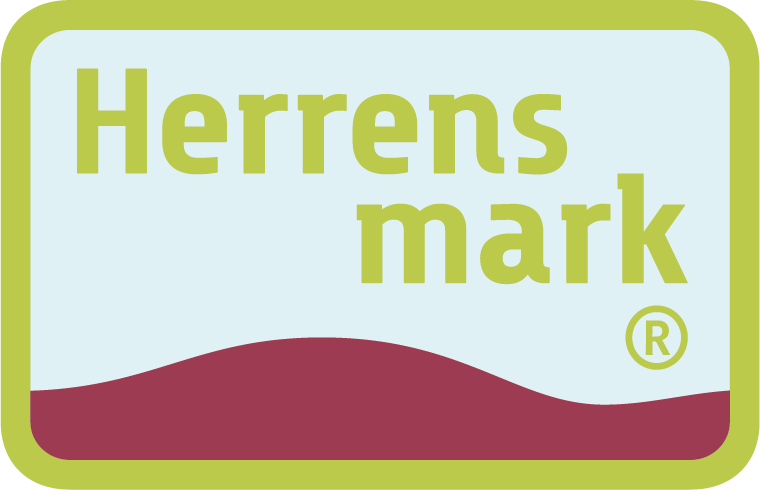Production of
herbal extracts
At Herrens Mark, we follow nature's own calendar. The annual cycle begins in spring, where we both harvest and sow our dandelions.
Nature's Treasure Trove
In early May, our dandelions are lovely and yellow, and the green leaves are crisp and brimming with juice and vitality. At this time both the dandelion flowers and leaves are harvested, after that comes the red clover harvest. Red clover is most nutrient-rich in the middle of summer when it is just about to blossom. The red clover extract is then used in the products REGOMEO and REGOBONE.
Finally, small batches of sage, mint and lemon balm are harvested when in season and added to the finished REGOMEO.
Pressing
Immediately after harvesting, the herbs are placed in the 6 x 1.5-metre tank. The large, cylindrical stainless-steel tank was originally made for Dong in connection with COP15 in Copenhagen for the purpose of producing bioethanol. Now it produces litres and litres of extract.
The mass is heated under controlled conditions to extract the liquid. Then everything is sent on to the press. The pressed juice is poured into one of the 15 large 20,000-litre tanks in the refrigerated storage room, while the excess pulp is returned to the fields and ploughed into the soil, providing nourishment for the next batch of crops.
Fermentation
One of the most essential processes in the making of the extract takes place in the large tanks. This is where we ferment the extract using lactic acid bacteria.. The extract is inoculated with an inoculum of lactic acid bacteria, produced by Herrens Mark and the fermentation process slowly begins. Along the way, carbon dioxide (CO2) is produced, and it requires experience and knowledge to control the process and ensure that the carbon dioxide is extracted before the extract is finally bottled.
During fermentation, the pH of the extract drops to around 4, where no bacteria other than lactic acid bacteria can survive.
Fermentation using lactic acid bacteria therefore has a preservative effect, allowing us to avoid alcohol or other forms of preservatives.
Packing
Once the extract is fermented and has been stored for long enough, it is piped back to the old farmhouse buildings where the packing room is located.
Here, the extract is poured into airtight bags using a custom-built machine which ensures that no oxygen comes into contact with the extract.
The bag-in-box solution, as it is called, ensures a long shelf life, precisely because the bag prevents oxygen from getting into the extract.
New Production Facility
In 2020, Herrens Mark received a grant from the European Agricultural Fund for a new production facility that can concentrate the fermented red clover extract by removing liquid. With the new production facility, it has become possible to standardise the red clover extract, ensuring a homogeneous content of the active ingredients, isoflavones. Read more here.
Our Extracts
REGOBONE 1 and 2 Litre – Organic
REGOMEO 1 & 2 Liter – Organic
REGOPUR 1 & 2 litre – Organic
What do other users say?
We have many satisfied users of our herbal extracts. Here you can read about others' experiences with REGOMEO, REGOBONE, and REGOPUR."
"Could feel the effect after just one day, and it's been like that ever since. I have now been taking fermented Red Clover Extract for 6 months. I am really happy with it and can't recommend it highly enough to others 😃""

REGOMEO
Lene"I started taking fermented red clover extract after consulting with my own doctor. I got "my life back"! It's fantastic to have a product for my bones where you get everything in one product: fermented red clover, calcium, and magnesium. I would definitely recommend REGOBONE. As for the taste, well, you get used to it 😂"

REGOBONE
Ingelise"I'm extremely happy with Herrens Mark’s dandelion product - REGOPUR. It is a great product that has now become a regular part of my breakfast routine and one that I can’t imagine doing without."

REGOPUR
Nina"Definitely 5 stars from me It's just fantastic. After 6 days, my hot flashes were completely gone ... 😄 Can't recommend it highly enough - it helps!"

REGOMEO
Kirsten"After a little over a year of using fermented red clover extract, I can say that it has greatly helped in maintaining my bones. So, despite the slightly funky taste, I'm sticking with it 😉 Thanks a million for your absolutely fantastic product."

REGOBONE
Tina"REGOPUR is wonderful! My digestion is so much better, and I have so much more energy - I really recommend it! :)"

REGOPUR
Alex"I just want to say a thousand thanks for making your fantastic red clover extract. In 14 days, I have regained my sleep and my life with full energy. I have never experienced an extract working so precisely and with such a great effect."

REGOMEO
Mirjam"I have been taking fermented red clover extract for a few years with a good effect on my bone loss. I have tried several different products, but the most effective method for maintaining and building my bones has been my daily intake of REGOBONE – which is reflected in my results. A natural product – which, for me, has been completely without side effects."

REGOBONE
Lise"I’ve been taking Fermented Dandelion Extract for six weeks and I can only give this product my best recommendations."




